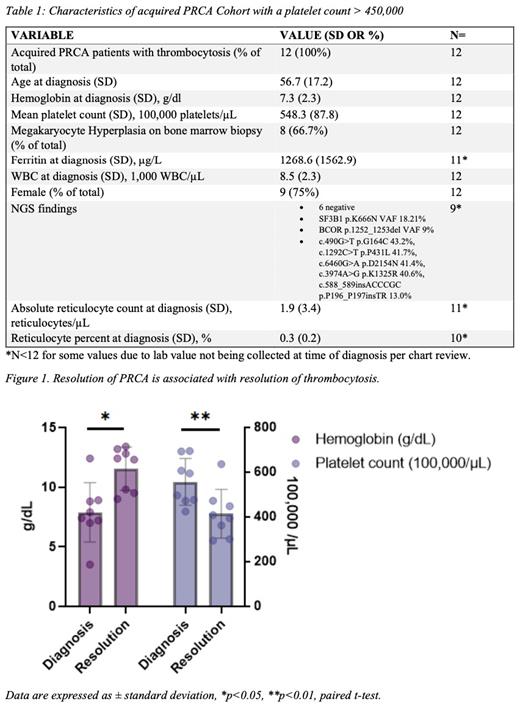J.A., R.G.W, and G.R. contributed equally to this abstract.
Introduction:
Acquired pure red cell aplasia (PRCA) is a rare hematological disorder characterized by normocytic, normochromic anemia with severe reticulocytopenia and a notable absence of identifiable erythroid precursors in the bone marrow. PRCA is often without a clear etiology and can be associated with conditions such as Large Granular Lymphocytic (LGL) Leukemias, B-cell dyscrasias, thymomas, immunodeficiencies or infections. Discovery of an IgG inhibitor in primary autoimmune pure red cell aplasia (PRCA) has been an immensely significant breakthrough. This finding has not only shed light on the critical role of IgG inhibitors in the pathophysiology of PRCA but has also underscored the importance of aberrant T cell activity in this condition. Thrombocytosis refers to an elevation in platelet count of >450,000/μL, which is not a typical feature associated with PRCA. Based on observations in our clinical practice of patients with PRCA with concomitant thrombocytosis, we screened our cohort for the combination of these features to discover potential mechanisms underlying this phenomenon.
Methods:
In order to address this objective, we conducted a retrospective analysis of medical records from 90 patients diagnosed with acquired PRCA at the University of Texas Southwestern and Cleveland Clinic Foundation between 2000 and 2022. Our primary goal was to determine the frequency of thrombocytosis among these patients. For those in the subset displaying thrombocytosis, longitudinal hemoglobin and platelet counts before and after treatment of the condition were also collected for relevant comparisons utilizing paired t-tests after assessing for normality with Shapiro-Wilk test.
Results:
Among a cohort of 90 patients diagnosed with acquired PRCA, 12 individuals exhibited thrombocytosis at the time of PRCA diagnosis (Table 1). Demographically, this subset of individuals had a median age of 53.5, and a 3:1 ratio of women to men. 66.7% of those with thrombocytosis also exhibited megakaryocyte hyperplasia on bone marrow biopsy. Molecular analysis ruled out the presence of myeloproliferative neoplasms, and blood work was obtained ruling out iron deficiency. Patients were treated for PRCA with a variety of medications including prednisone, cyclosporine, tacrolimus, rituximab, and cyclophosphamide. After treatment, 8 of the 12 patients demonstrated complete resolution of their PRCA, defined as transfusion independence with hemoglobin levels above 10. Further examination of those 8 patients with resolution of PRCA revealed statistically significant differences in mean hemoglobin and platelet counts before and after treatment (Figure 1). Specifically, the mean hemoglobin count increased from 7.9 (SD 2.5) g/dL to11.6 (1.8) g/dL (p=0.0168), while the platelet count decreased from 557,300 (SD 104,700) /μL to 414,400 (SD 109,600) /μL (p=0.0049).
Conclusion:
Our report is the most comprehensive case series to date reporting on thrombocytosis in patients with acquired PRCA. We speculate that the arrest of erythropoiesis generating PRCA may lead to skewing of precursors towards the megakaryocytic lineage. Alternatively, EPO production secondary to PRCA could stimulate TPO receptors and thus stimulate platelet production. Clinicians should be aware of this particular PRCA presentation. Further investigations will aid in elucidating whether one of these mechanisms may also be playing a role in PRCA-related thrombocytosis.
The significance of thrombocytosis or megakaryocyte alterations in PRCA remains enigmatic, necessitating further investigations to elucidate their role in disease pathophysiology, as well as their utility as biomarkers for treatment response prediction. The limitations of this study encompass a small sample size and the absence of post-treatment bone marrow biopsy results, which would have facilitated the visual assessment of any resolved megakaryocyte abnormalities. Future directions include examining megakaryocyte hyperplasia and other megakaryocyte abnormalities such as hyper- and hypo-lobation associated with PRCA.
Disclosures
Maciejewski:Novartis: Honoraria, Speakers Bureau; Regeneron: Consultancy, Honoraria; Alexion: Membership on an entity's Board of Directors or advisory committees; Omeros: Consultancy. Bat:Alexion pharma: Membership on an entity's Board of Directors or advisory committees.


This feature is available to Subscribers Only
Sign In or Create an Account Close Modal